Ask any coffee professional what the most important tool is in brewing better coffee at home, and you’ll likely hear the same answer: a good grinder. And not just any grinder—a burr grinder. While many beginners start with blade grinders, switching to burrs can dramatically improve the taste and consistency of your coffee.
In this article, we’ll explain the differences between blade and burr grinders, why burr grinders matter, and how to choose the right one for your brewing needs.
Why Grinding Fresh Matters
Before diving into grinder types, it’s important to understand why grinding your coffee fresh is so essential:
- Preserves aroma: Coffee begins losing its aroma within minutes of grinding.
- Improves extraction: Fresh grounds allow water to extract flavor more efficiently.
- Controls brew strength: Adjusting grind size directly affects taste and balance.
- Reduces waste: You can grind exactly what you need, no more or less.
Whether you’re using a French press or espresso machine, grinding right before brewing is a game-changer.
Blade Grinders: Inexpensive but Inconsistent
Blade grinders use spinning metal blades to chop coffee beans. They resemble blenders and are popular for their affordability.
Pros:
- Very inexpensive (usually under $30)
- Widely available
- Compact and easy to store
Cons:
- Uneven grind: Blades chop rather than grind, producing inconsistent particle sizes.
- Heat buildup: Fast spinning blades can heat the beans, altering flavor.
- No grind control: Difficult to adjust for different brew methods.
Best used for:
- Casual brewing where precision isn’t crucial
- Drip machines or basic French press setups (with tolerance for inconsistency)
While blade grinders are better than pre-ground coffee, they limit your ability to make high-quality brews consistently.
Burr Grinders: Consistency and Control
Burr grinders use two abrasive surfaces (called burrs) that crush beans to a uniform size. You can adjust the distance between the burrs to control grind size precisely.
Types of Burr Grinders:
- Flat burrs: Offer high precision and consistent particle size; found in prosumer and commercial models.
- Conical burrs: More common in home grinders; efficient, quieter, and great for all brew methods.
Pros:
- Uniform grind size for balanced extraction
- Grind size adjustability for different brewing methods
- Better flavor due to reduced fines and boulders
- Long-term durability
Cons:
- More expensive upfront ($70–$300+)
- Larger footprint on the counter
- May require regular cleaning for peak performance
Burr grinders are essential for serious home brewers who want consistent results with pour-over, espresso, AeroPress, or cold brew.
How Burr Grinders Affect Flavor
Grind size determines extraction rate, which influences whether your coffee tastes:
- Sour and weak (under-extracted from too coarse a grind)
- Bitter and dry (over-extracted from too fine a grind)
- Balanced and flavorful (ideal extraction)
Because burr grinders offer precise control over grind size, they allow you to dial in your brews based on:
- Brewing method (e.g., V60, French press, espresso)
- Coffee origin and roast level
- Water temperature and brew time
This control leads to better tasting coffee, shot after shot, cup after cup.
Manual vs Electric Burr Grinders
Both manual and electric burr grinders have their place, depending on your needs.
Manual Burr Grinders
Pros:
- Compact and travel-friendly
- More affordable
- Quiet operation
Cons:
- Requires effort to grind
- Slower, especially for large batches
Best for: Beginners, travelers, or single-cup brewers
Electric Burr Grinders
Pros:
- Fast and convenient
- Great for batch brewing or espresso
- Consistent at scale
Cons:
- Higher cost
- Louder and requires electricity
Best for: Home setups with daily use or espresso machines
Recommended Burr Grinders by Skill Level
Entry-Level:
- Timemore C2/C3 (manual) – Affordable, precise, great for pour-over or AeroPress
- Baratza Encore (electric) – Reliable, simple, great for French press and drip
Mid-Range:
- 1Zpresso JX or X-Pro (manual) – High build quality and exceptional grind consistency
- Baratza Virtuoso+ – Upgraded motor and timer for faster grinding and espresso readiness
High-End:
- Eureka Mignon Specialita – Quiet, stepless adjustment, perfect for espresso
- Fellow Ode Gen 2 – Designed for filter brewing with powerful flat burrs and modern design
Burr Maintenance: Keeping Your Grinder Clean
Even the best burr grinders need care to stay effective.
Weekly:
- Brush out excess grounds with a soft grinder brush
Monthly:
- Disassemble and clean burrs
- Use grinder cleaning tablets (like Urnex Grindz)
- Check for burr alignment (in high-end models)
A clean grinder ensures better flavor and extends the life of the machine.
Final Thoughts: Invest in a Burr Grinder First
If you’re only going to upgrade one part of your coffee setup, make it the grinder. A high-quality burr grinder does more for your brew than almost any other tool.
By switching from blade to burr, you unlock more flavor, control, and consistency. Whether you’re just starting out or refining your skills, a burr grinder is your foundation for great coffee at home.

